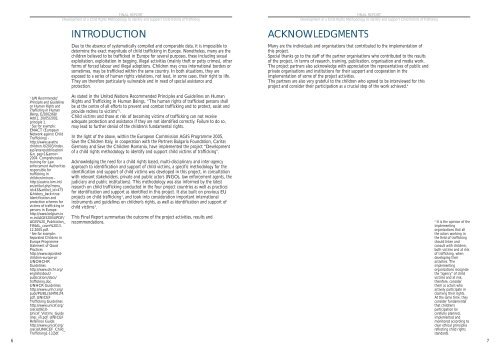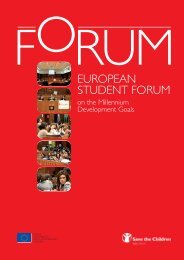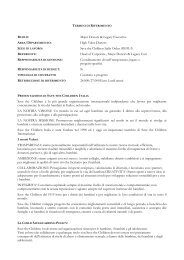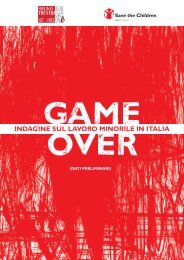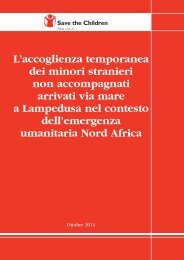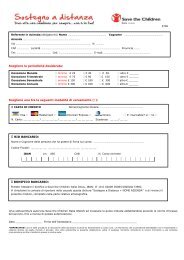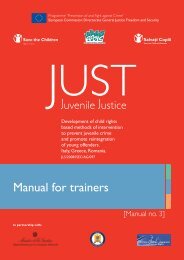FINAL REPORT - Save the Children Italia Onlus
FINAL REPORT - Save the Children Italia Onlus
FINAL REPORT - Save the Children Italia Onlus
Create successful ePaper yourself
Turn your PDF publications into a flip-book with our unique Google optimized e-Paper software.
<strong>FINAL</strong> <strong>REPORT</strong>Development of a Child Rights Methodology to Identify and Support Child Victims of TraffickingINTRODUCTIONDue to <strong>the</strong> absence of systematically compiled and comparable data, it is impossible todetermine <strong>the</strong> exact magnitude of child trafficking in Europe. None<strong>the</strong>less, many are <strong>the</strong>children believed to be trafficked in Europe for several purposes, <strong>the</strong>se including sexualexploitation, exploitation in begging, illegal activities (mainly <strong>the</strong>ft or petty crimes), o<strong>the</strong>rforms of forced labour and illegal adoptions. <strong>Children</strong> may cross international borders orsometimes, may be trafficked within <strong>the</strong> same country. In both situations, <strong>the</strong>y areexposed to a series of human rights violations, not least, in some cases, <strong>the</strong>ir right to life.They are <strong>the</strong>refore particularly vulnerable and in need of special assistance andprotection.<strong>FINAL</strong> <strong>REPORT</strong>Development of a Child Rights Methodology to Identify and Support Child Victims of TraffickingACKNOWLEDGMENTSMany are <strong>the</strong> individuals and organisations that contributed to <strong>the</strong> implementation ofthis project.Special thanks go to <strong>the</strong> staff of <strong>the</strong> partner organisations who contributed to <strong>the</strong> resultsof <strong>the</strong> project, in terms of research, training, publication, organisation and media work.The project partners also acknowledge with appreciation <strong>the</strong> representatives of public andprivate organisations and institutions for <strong>the</strong>ir support and cooperation in <strong>the</strong>implementation of some of <strong>the</strong> project activities.The partners are also very grateful to <strong>the</strong> children who agreed to be interviewed for thisproject and consider <strong>the</strong>ir participation as a crucial step of <strong>the</strong> work achieved. 41UN RecommendedPrinciples and Guidelineson Human Rights andTrafficking in HumanBeings, E/2002/68/Add.1, 20/05/2002,principle 1.2See for example:ENACT (EuropeanNetwork against ChildTrafficking) -http://www.save<strong>the</strong>children.it/2003/index.asp?area=pubblicazioni&n_pag=1&anno=2004. Comprehensivetraining for Lawenforcement Authoritiesresponsible fortrafficking inchildren/minors -http://austria.iom.int/en/artikel.php?menu_id=43&artikel_id=473&history_back=true.Identification andprotection schemes forvictims of trafficking inpersons in Europehttp://www.belgium.iom.int/AGIS2004/PDF/AGIS%20_Publication_<strong>FINAL</strong>_cover%2013.12.2005.pdf.3See for example:Separated <strong>Children</strong> inEurope ProgrammeStatement of GoodPractices:http://www.separatedchildren-europe-prUNOHCHRGuidelines:http://www.ohchr.org/english/about/publications/docs/trafficking.doc.UNHCR Guidelines:http://www.unhcr.org/publ/PUBL/3d4f91cf4.pdf. UNICEFTrafficking Guidelines:http://www.unicef.org/ceecis/0610-Unicef_Victims_Guidelines_en.pdf. UNICEFReference Guide:http://www.unicef.org/ceecis/UNICEF_Child_Trafficking1-13.pdf.As stated in <strong>the</strong> United Nations Recommended Principles and Guidelines on HumanRights and Trafficking in Human Beings, “The human rights of trafficked persons shallbe at <strong>the</strong> centre of all efforts to prevent and combat trafficking and to protect, assist andprovide redress to victims” 1 .Child victims and those at risk of becoming victims of trafficking can not receiveadequate protection and assistance if <strong>the</strong>y are not identified correctly. Failure to do so,may lead to fur<strong>the</strong>r denial of <strong>the</strong> children’s fundamental rights.In <strong>the</strong> light of <strong>the</strong> above, within <strong>the</strong> European Commission AGIS Programme 2005,<strong>Save</strong> <strong>the</strong> <strong>Children</strong> Italy, in cooperation with <strong>the</strong> Partners Bulgaria Foundation, CaritasGermany and <strong>Save</strong> <strong>the</strong> <strong>Children</strong> Romania, have implemented <strong>the</strong> project “Developmentof a child rights methodology to identify and support child victims of trafficking”.Acknowledging <strong>the</strong> need for a child rights based, multi-disciplinary and inter-agencyapproach to identification and support of child victims, a specific methodology for <strong>the</strong>identification and support of child victims was developed in this project, in consultationwith relevant stakeholders, private and public actors (NGOs, law enforcement agents, <strong>the</strong>judiciary and public institutions). This methodology was also informed by <strong>the</strong> latestresearch on child trafficking conducted in <strong>the</strong> four project countries as well as practicesfor identification and support as identified in this project. It also built on previous EUprojects on child trafficking 2 , and took into consideration important internationalinstruments and guidelines on children’s rights, as well as identification and support ofchild victims 3 .This Final Report summarises <strong>the</strong> outcome of <strong>the</strong> project activities, results andrecommendations.4It is <strong>the</strong> opinion of <strong>the</strong>implementingorganizations that all<strong>the</strong> actors working in<strong>the</strong> field of traffickingshould listen andconsult with children,both victims and at riskof trafficking, whendeveloping <strong>the</strong>iractivities. Theimplementingorganizations recognize<strong>the</strong> “agency” of childvictims and at risk,<strong>the</strong>refore, consider<strong>the</strong>m as actors whoactively participate inclaiming <strong>the</strong>ir rights.At <strong>the</strong> same time, <strong>the</strong>yconsider fundamentalthat children’sparticipation becarefully planned,implemented andmonitored according toclear ethical principlesreflecting child rightsstandards.6 7


